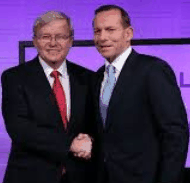
Cross-posted from The Conversation
Australia’s 2013 election campaign is noteworthy not just for the ferocity of the party leaders’ exchanges on tax and policy costings but also for the corresponding absence of any substantial debate on competing visions of our economic future. As Nobel prize winning economist Professor Joe Stiglitz observed earlier in the week: “the obsession with public debt continues to be a distraction from the more fundamental question of how to establish sustainable long-run growth”.
At the start of the campaign, prime minister Kevin Rudd provided a brief but promising glimpse with a speech to the National Press Club on Australia’s competitiveness challenge and how to address it. He recognised that with declining terms of trade signalling an end to the commodity price phase of the resources boom, there was now an acute need to diversify our sources of growth and boost productivity performance.
Yet while Rudd bravely claimed that “what the Australian people now want to see is a debate about a clear, positive economic policy direction for their future”, subsequent debate was very quickly side-tracked. Even opposition leader Tony Abbott found it hard to attract attention in the maelstrom to the Coalition’s numerous policy launches, and faced remarkably little pressure to elaborate his own alternative vision.
Key to competitiveness
There is widespread acknowledgement among economists and policy-makers that the key to improving competitiveness and productivity is to build innovation capability at the level of the enterprise, particularly through development of innovation “ecosystems” with research and education institutions. It is also understood that innovation is not just about technology but also non-technological innovation such as new business models, design integration and high performance work and management practices.
How do the party policies measure up to this important national task, and will they deliver on key priorities? Labor’s approach is a known quantity, though with some additions and embellishments in this week’s policy launch. Echoing the Business Council of Australia, as well as experience with “smart specialisation” in high cost economies, there is a proposal for a new National Innovation Council, which will identify future enabling technologies and capabilities and set priorities with sectoral industry innovation bodies.
In this context, Labor has also announced 12 strategic “Innovation Partnerships” in advanced manufacturing, food, medical technologies, mining equipment, oil and gas, biopharmaceuticals, sports technologies, transport and logistics, space technologies, sustainable development, financial services and the creative digital industries. Such partnerships provide an opportunity to integrate Australian ideas and expertise with global value chains.
There is also a commitment to “success stories” such as Enterprise Connect, which has delivered business improvement services to over 20,000 firms, to entrepreneurial start-up funding through Commercialisation Australia and Venture Australia and to more competitive access by local industry suppliers to large resources projects and public sector contracts. Australian governments have been much more reticent than those overseas in using public procurement to promote local small and medium enterprise technology development.
Failure to communicate
The problem for Labor does not lie in any inherent weakness in its policy programs but in the failure to communicate them as part of a coherent economic narrative and in the related damage to its credibility by repeated budget driven “raids on Peter to pay Paul”.
This occurred most prominently with the withdrawal of R&D tax concessions from large companies to fund the Innovation Partnerships, despite the crucial contribution of these companies to the national innovation effort, and with the higher education cuts to fund the Gonski school reforms.
While Labor’s communication and delivery of innovation priorities may be found wanting, despite the strong advocacy of Minister Kim Carr, its support for Australia’s transition to a knowledge-based economy is clear. By contrast, the Coalition is yet to play its hand, though there have been some important policy announcements, including a detailed commitment this week to “provide leadership on the digital economy”, and a somewhat less detailed proposal to “boost the competitiveness of Australian manufacturing”.
Whatever the merits of fibre-to-the-node versus fibre-to-the-premises in the context of the National Broadband Network, the Coalition’s digital economy policy offers a sophisticated understanding of the transformative potential of digital technologies.
In particular, it notes that “a more digital, networked economy is about far more than broadband. It is about tumultuous change in workplaces – and the skills and capabilities individuals and firms need to succeed”.
Scorched earth
If only the same could be said for the Coalition’s approach to industry and innovation, which is “back to the future”. The manufacturing policy proposes a new Minister for Trade and Investment to encourage more direct investment, a manufacturing industry transition program, a rethink of R&D tax incentives, a restoration of export market development grants and the development of “Strategic Growth Action Agendas”. These measures are unexceptional but do not amount to a national innovation policy.
Does the Coalition’s approach imply that the innovation programs developed with active industry involvement over the last few years are being targeted for major cost savings? If so, it would be a short-sighted move, not least because some of these programs were actually initiated by the Howard government before it left office. For example, Enterprise Connect has its origins in the Industry Productivity Centres, and the Innovation Partnerships in the Global Opportunities Program.
Understandably, new governments have an interest in putting their own stamp on policy, particularly in areas as critical to our future as research and innovation, but sometimes continuity and re-badging is preferable to scorched earth.
Article by Roy Green, Dean of UTS Business School at University of Technology, Sydney
______________________________________________________________________________________
UE here. If the Government truly wants to boost innovation and productivity, the single best thing that it can do is undertake reforms that break-down market power and enhance competition throughout the economy. Developing an agenda of competition reforms should be a priority of the next Government, not the heavy handed programs and “picking winners” approaches outlined above.

